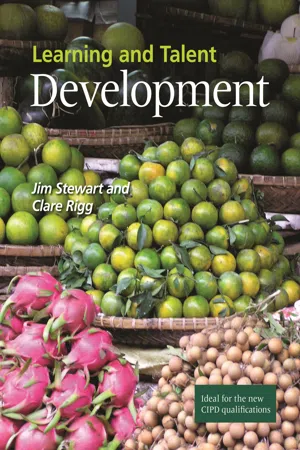![]()
![]()
CHAPTER 1
Introduction
OVERVIEW
Learning and talent development is the name of one of the modules in the new CIPD advanced-level qualifications. The new qualifications are one element in a revised approach to professional membership of the CIPD. The new learning and talent development module provides one reason for writing this book. Thus this book is intended to support those studying the subject and that module. A second reason is that both authors have been researching and writing on the topic of human resource development (HRD) for many years, both separately and together. The book provides an opportunity to share and disseminate our joint thinking and our current and shared view of the subject based on that research. It is fair to say that the content of the book is the result of our thinking as much as it is of empirical research, although the latter clearly informs the former. An additional reason for the book is that both authors share a commitment to influencing and, as far as we can, shaping professional practice. We hold a common commitment to promoting a more critical approach to that practice and a shared belief that education is a significant and effective means of developing critical practice. Hence, within the confines of ‘textbook’, we seek to show the nature and benefits of a critical understanding of and approach to the professional practice of learning and talent development.
We should perhaps say a brief word at this point about the terms ‘learning and talent development’ and ‘HRD’. Most of our previous joint and separate writing has been within the framework of HRD rather than learning and talent development. Later chapters will examine the meaning of each in more detail. For now we will say that ‘HRD’ is a term more commonly used by academics than by practitioners, while ‘learning and talent development’ is a term associated with the recent rise in interest in the notion of talent and so may suggest a specific focus for HRD. As a general rule of thumb the terms can be seen as synonymous, but there can be significant nuances of meaning attached to each that make a case for having both to represent different concepts. We do, though, use them interchangeably in this first chapter.
FOLLOW UP
See Chapter 2 for an initial discussion of key terms.
PURPOSE, AIMS AND OBJECTIVES
We have opened the book by declaring our reasons for writing it. These give some indication of the purpose of the book. However, it is useful to devote particular and direct attention to aims and objectives. Doing so reflects what is considered good practice in learning and development and, therefore, declaring a purpose in specific detail will illustrate that practice. In addition, it will provide some means for readers to judge both the relevance and success of the book. The overall aims of the book are as follows:
• to introduce and explore concepts associated with and relevant to the syllabus of the CIPD Learning and Talent Development module
• to provide a practical and accessible exposition of key theories informing the professional practice of HRD/learning and talent development
• to provide a useful and useable resource to support the teaching and learning of HRD/learning and talent development as an academic subject
• to facilitate and support a critically informed examination of the theory and practice of HRD/learning and talent development.
It will be worth expanding on these aims. They suggest a clear connection with the CIPD syllabus, and this is deliberate. The book is intended to cover the ground indicated in the CIPD learning and talent development module descriptor. However, this does not mean that the syllabus has determined the content or that we have provided either all the information or only information relevant to that syllabus. The book has an openly declared purpose of preparing students for assessment against the CIPD syllabus. This purpose is achieved, however, by our interpretation of the syllabus in terms of which are the key or critical concepts, and in terms of the understanding required to utilise and apply those concepts in professional practice.
This raises a second important point about the aims of the book. While the final aim explicitly assumes a separation between theory and practice, we do not believe such a separation is either valid or useful. We share the CIPD philosophy that professional certification must mean the ability to practise in the profession. Therefore a key purpose of the book is to help equip individuals to meet the expectations placed upon those performing specialist roles in developing others. This ‘practice’ orientation and purpose is reflected in the title of the book.
A final point on the CIPD connection is to recognise that the book is intended to have relevance to and application in the study of HRD as a subject. This means that its content is not restricted to the CIPD module but is intended to have value in the full range of learning and development-related modules in the CIPD advanced qualifications. Particular chapters will, of course, have greater or lesser relevance to particular modules. However, as indicated above, the book is intended to support the teaching and learning of learning and talent development as a subject rather than being restricted to one specific syllabus.
Two more points are worth articulating. First, we have attempted to create a resource which will be valuable both to those teaching and to those learning HRD. Although the book is written primarily for those learning to practise learning and talent development, we believe and hope that the content will include some insights and perspectives which will give pause for thought on the part of experienced teachers of the subject. We will not achieve our grand purpose of influencing development of the subject unless this is the case. So our intention is that the book will provide a resource of interest and value to both teachers and learners in their joint examination and exploration of the subject.
The final point to make about the aims of the book is that we wish to encourage alternative paradigms and perspectives to be applied to support critical thinking about the subject. We have sought to achieve a similar aim in previous joint work but do not believe we can go further in a book with an overt aim of supporting entry to professional practice through meeting the syllabus and requirements of a professional body. However, we have deliberately introduced concepts and theories from outside mainstream treatments of learning and talent development, and equally deliberately encourage their use in evaluating the validity and utility of mainstream treatments.
This statement and discussion of the aims of the book allows us to articulate some clear objectives. Again reflecting what is considered good practice in HRD and indeed in teaching and learning practices in higher education, these are expressed in terms of what readers can expect to have achieved through using the book:
• to explain and analyse the national and organisational context of learning and talent development
• to describe, compare and critically evaluate a range of theories and concepts related to individual and organisational learning
• to describe, compare and critically evaluate a range of approaches to and methods of applying learning and talent development in practice
• to identify, explain and critically evaluate the assumed functions and activities associated with managing learning and talent development in the context of professional practice.
READERSHIP
It will be clear by now that a primary readership for the book will be anyone studying HRD/learning and talent development as part of their CIPD qualification programme. This will include those studying in universities that provide their own postgraduate diploma or Masters degree courses accredited by the CIPD, as well as those studying for CIPD qualifications in approved centres. However, the book has not been written exclusively for this audience and other readers are envisaged and expected. In fact, all those who ‘study’ HRD, including academics, constitute the intended readership. It is, however, possible to identify some specific audiences.
It seems to be an increasing trend to include HRD in undergraduate studies. We have in mind potential readers at undergraduate level, although we have assumed they will be final-year students who have either recent or current exposure to and experience of employment and/or management practices in work organisations. As already stated, the book is concerned with application. Therefore its value to undergraduate studies will be limited to the extent that students can relate personal experience of work organisations to the content. This experience does not have to be in practitioner roles. However, the book has not been written to consider the subject at a purely or exclusively conceptual level, and achievement of its aims and objectives assumes and requires regular interaction between reader and text based on personal experience. The book is relevant then only to the extent that such interaction can be achieved.
There are a number of other postgraduate programmes where the book will be relevant. Perhaps the most obvious of thes...

